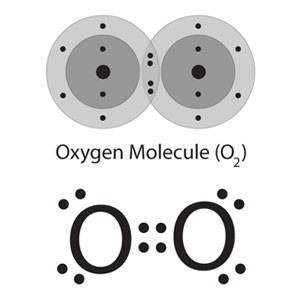You obviously know what oxygen is. Don’t you? It is what makes life possible on earth. But, do you know anything more than that? In this chapter, we will learn about Dioxygen. We will look at its properties, preparation methods and uses. Let’s begin.
Suggested Videos
What is Dioxygen?
Similar to Group 14 and 15, the lightest member of group 16 has the best inclination to shape numerous bonds. In this way, elemental Oxygen is found in nature as a diatomic gas that contains a net twofold bond: O=O. Dioxygen means the normal allotrope of oxygen having two atoms of oxygen in the molecule.

Likewise, with nitrogen, electrostatic repulsion between lone pair of electrons on adjoining atoms keeps oxygen from framing stable catenated compounds. Ozone (O3), a standout amongst the most intense oxidants known, is utilized to cleanse drinking water since it doesn’t deliver the characteristic taste connected with chlorinated water.
Equation
2H2O2 (l) → 2H2O(l) + O2 (g)
ΔG° = −119 kJ/mol
Regardless of the quality of the O = O bond (DO2 = 494 kJ/mol), O2 is amazingly reactive, that reacts straightforwardly with almost all different elements aside from the noble gasses. A few properties of O2 and related species, for example, the peroxide and superoxide particles, are mentioned in the accompanying table:
Species |
Bond Order |
Number of unpaired e– |
O- O distance (pm) |
| O2 | 2 | 2 | 121 |
| O2+ | 2.5 | 1 | 112 |
| O2– | 1.5 | 1 | 133 |
| O22- | 1 | 0 | 149 |
Preparation
The most advantageous technique for making oxygen in the laboratory includes the catalytic decay of potassium chlorate in the solid form where manganese dioxide works as a catalyst.
Δ
2KClO3 → 2KCl + 3O2
MnO2
Another laboratory technique includes the thermal disintegration of metal oxides from the lower part of the electrochemical arrangement. For example, the thermal decomposition of mercuric oxide or silver oxide gives oxygen.
2HgO → 2Hg + O2
Mercuric oxide Δ Mercury Dioxygen
2Ag2O → 4Ag + O2
Silver oxide Δ Silver Dioxygen
We can also prepare oxygen in the laboratory by thermal treatment of the higher oxides of some metals like lead, manganese and barium.
2PbO2 → 2PbO + O2
Lead (IV) oxide Δ Lead (II) oxide Dioxygen
2MnO2 + 2H2SO4 → 2MnSO4 + 2H2O + O2
Manganese Sulphuric Δ Manganese Water Dioxygen
(IV) oxide (II) sulphate
2BaO2 → 2BaO + O2
Barium peroxide Δ Barium oxide Dioxygen
Salts that are rich in oxygen, such as permanganates and nitrates, when decomposed thermally also yields oxygen.
2KNO3 → 2KNO2 + O2
Potassium nitrate Potassium nitrite Dioxygen
2KMnO4 → K2MnO4 + MnO2 + O2
Potassium Δ Potassium manganese Dioxygen
permanganate manganate (IV) oxide
2NaNO3 → 2NaNO2 + O2
Sodium nitrate Δ Sodium nitrate Dioxygen
Physical Properties
- Oxygen is a tasteless, colourless and scentless gas.
- It is marginally heavier than air.
- It is marginally soluble in water. This little amount of oxygen dissolved is quite adequate to support the aquatic and marine life.
- Under pressure, we can condense it to a light blue fluid by compacting the gas at 90K. It can likewise be solidified into a bluish white solid at 55K.
Chemical Properties
Oxygen is an exceptionally reactive element and reacts straightforwardly with almost all metals and non-metals. It doesn’t react straightforwardly with a few metals like gold and platinum and some noble gases like helium, argon, and neon.
1) The Reaction With Metals
Most metals blaze in oxygen and frame oxides that are for the most part basic in nature.
Metal Dioxygen Metal-oxide
2M + O2 → 2MO
4M + O2 → 2M2O
4M + 3O2 → 2M2O3
A large portion of non-metals burns within the presence of oxygen structures acidic oxides. Example: Sulfur blazes within the presence of oxygen gives sulfur dioxide.
S + O2 → SO2
2) Reactions With Some Compounds
Sulfur dioxide experiences catalytic oxidation within the presence of vanadium pentoxide(V2O5) to frame sulfur trioxide. This is a critical stride in the production of sulphuric acid by the contact procedure.
2SO2 + O2 → 2SO3
Oxygen reacts with many organic compounds such as carbohydrates and hydrocarbons, at hoisted temperatures or on start, resulting in the formation of carbon dioxide and water.
High Temperature
CH4 + 2O2 → CO2 + 2H2O
Methane Dioxygen Carbon dioxide Water
High Temperature
C6H12O6 + 6O2 → 6CO2 + 6H2O
Glucose Dioxygen Carbon dioxide Water
Dioxygen Difluoride
Dioxygen Difluoride with the formula O2F2 is a compound of fluorine and oxygen. It can exist as an orange-coloured solid which liquefies into a red fluid at −163 °C (110 K). It is to a great degree solid oxidant and breaks down into oxygen and fluorine even at −160 °C (113 K) at a rate of 4% every day: its lifetime at room temperature is in this manner amazingly short. Dioxygen difluoride reacts energetically with about each concoction it experiences – even common ice – prompting to its onomatopoeic label “FOOF.”
Solved Example For You
Q: Write down the uses of oxygen.
Ans: The fundamental significance of dioxygen lies in its support to key procedures. For example, respiration and combustion. Its other uses are mentioned below.
- Dioxygen blended with carbon dioxide or helium is utilized for artificial respiration.
- It is utilized as a part of manufacturing many metals.
- It is utilized as a part of oxy-acetylene welding and metal cutting.
- Oxygen is utilized to oxidize ammonia in the nitric acid preparation.
- Oxygen barrels are broadly utilized as a part of healing facilities, high-height flying and in mountaineering.
- Liquid oxygen is an essential constituent of the fuel utilized as a part of rockets.






Leave a Reply